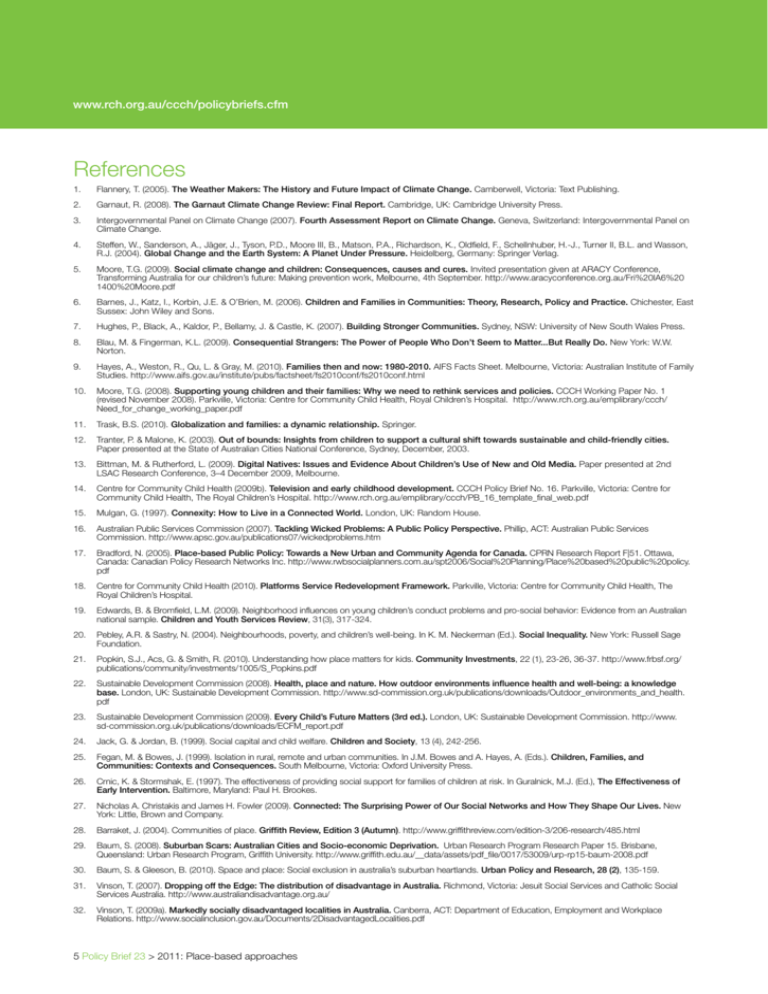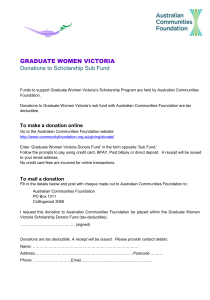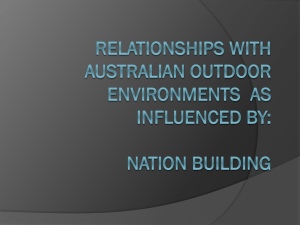References - The Royal Children's Hospital
advertisement

www.rch.org.au/ccch/policybriefs.cfm References 1. Flannery, T. (2005). The Weather Makers: The History and Future Impact of Climate Change. Camberwell, Victoria: Text Publishing. 2. Garnaut, R. (2008). The Garnaut Climate Change Review: Final Report. Cambridge, UK: Cambridge University Press. 3. Intergovernmental Panel on Climate Change (2007). Fourth Assessment Report on Climate Change. Geneva, Switzerland: Intergovernmental Panel on Climate Change. 4. Steffen, W., Sanderson, A., Jäger, J., Tyson, P.D., Moore III, B., Matson, P.A., Richardson, K., Oldfield, F., Schellnhuber, H.-J., Turner II, B.L. and Wasson, R.J. (2004). Global Change and the Earth System: A Planet Under Pressure. Heidelberg, Germany: Springer Verlag. 5. Moore, T.G. (2009). Social climate change and children: Consequences, causes and cures. Invited presentation given at ARACY Conference, Transforming Australia for our children’s future: Making prevention work, Melbourne, 4th September. http://www.aracyconference.org.au/Fri%20IA6%20 1400%20Moore.pdf 6. Barnes, J., Katz, I., Korbin, J.E. & O’Brien, M. (2006). Children and Families in Communities: Theory, Research, Policy and Practice. Chichester, East Sussex: John Wiley and Sons. 7. Hughes, P., Black, A., Kaldor, P., Bellamy, J. & Castle, K. (2007). Building Stronger Communities. Sydney, NSW: University of New South Wales Press. 8. Blau, M. & Fingerman, K.L. (2009). Consequential Strangers: The Power of People Who Don’t Seem to Matter...But Really Do. New York: W.W. Norton. 9. Hayes, A., Weston, R., Qu, L. & Gray, M. (2010). Families then and now: 1980-2010. AIFS Facts Sheet. Melbourne, Victoria: Australian Institute of Family Studies. http://www.aifs.gov.au/institute/pubs/factsheet/fs2010conf/fs2010conf.html 10. Moore, T.G. (2008). Supporting young children and their families: Why we need to rethink services and policies. CCCH Working Paper No. 1 (revised November 2008). Parkville, Victoria: Centre for Community Child Health, Royal Children’s Hospital. http://www.rch.org.au/emplibrary/ccch/ Need_for_change_working_paper.pdf 11. Trask, B.S. (2010). Globalization and families: a dynamic relationship. Springer. 12. Tranter, P. & Malone, K. (2003). Out of bounds: Insights from children to support a cultural shift towards sustainable and child-friendly cities. Paper presented at the State of Australian Cities National Conference, Sydney, December, 2003. 13. Bittman, M. & Rutherford, L. (2009). Digital Natives: Issues and Evidence About Children’s Use of New and Old Media. Paper presented at 2nd LSAC Research Conference, 3–4 December 2009, Melbourne. 14. Centre for Community Child Health (2009b). Television and early childhood development. CCCH Policy Brief No. 16. Parkville, Victoria: Centre for Community Child Health, The Royal Children’s Hospital. http://www.rch.org.au/emplibrary/ccch/PB_16_template_final_web.pdf 15. Mulgan, G. (1997). Connexity: How to Live in a Connected World. London, UK: Random House. 16. Australian Public Services Commission (2007). Tackling Wicked Problems: A Public Policy Perspective. Phillip, ACT: Australian Public Services Commission. http://www.apsc.gov.au/publications07/wickedproblems.htm 17. Bradford, N. (2005). Place-based Public Policy: Towards a New Urban and Community Agenda for Canada. CPRN Research Report F|51. Ottawa, Canada: Canadian Policy Research Networks Inc. http://www.rwbsocialplanners.com.au/spt2006/Social%20Planning/Place%20based%20public%20policy. pdf 18. Centre for Community Child Health (2010). Platforms Service Redevelopment Framework. Parkville, Victoria: Centre for Community Child Health, The Royal Children’s Hospital. 19. Edwards, B. & Bromfield, L.M. (2009). Neighborhood influences on young children’s conduct problems and pro-social behavior: Evidence from an Australian national sample. Children and Youth Services Review, 31(3), 317-324. 20. Pebley, A.R. & Sastry, N. (2004). Neighbourhoods, poverty, and children’s well-being. In K. M. Neckerman (Ed.). Social Inequality. New York: Russell Sage Foundation. 21. Popkin, S.J., Acs, G. & Smith, R. (2010). Understanding how place matters for kids. Community Investments, 22 (1), 23-26, 36-37. http://www.frbsf.org/ publications/community/investments/1005/S_Popkins.pdf 22. Sustainable Development Commission (2008). Health, place and nature. How outdoor environments influence health and well-being: a knowledge base. London, UK: Sustainable Development Commission. http://www.sd-commission.org.uk/publications/downloads/Outdoor_environments_and_health. pdf 23. Sustainable Development Commission (2009). Every Child’s Future Matters (3rd ed.). London, UK: Sustainable Development Commission. http://www. sd-commission.org.uk/publications/downloads/ECFM_report.pdf 24. Jack, G. & Jordan, B. (1999). Social capital and child welfare. Children and Society, 13 (4), 242-256. 25. Fegan, M. & Bowes, J. (1999). Isolation in rural, remote and urban communities. In J.M. Bowes and A. Hayes, A. (Eds.). Children, Families, and Communities: Contexts and Consequences. South Melbourne, Victoria: Oxford University Press. 26. Crnic, K. & Stormshak, E. (1997). The effectiveness of providing social support for families of children at risk. In Guralnick, M.J. (Ed.), The Effectiveness of Early Intervention. Baltimore, Maryland: Paul H. Brookes. 27. Nicholas A. Christakis and James H. Fowler (2009). Connected: The Surprising Power of Our Social Networks and How They Shape Our Lives. New York: Little, Brown and Company. 28. Barraket, J. (2004). Communities of place. Griffith Review, Edition 3 (Autumn). http://www.griffithreview.com/edition-3/206-research/485.html 29. Baum, S. (2008). Suburban Scars: Australian Cities and Socio-economic Deprivation. Urban Research Program Research Paper 15. Brisbane, Queensland: Urban Research Program, Griffith University. http://www.griffith.edu.au/__data/assets/pdf_file/0017/53009/urp-rp15-baum-2008.pdf 30. Baum, S. & Gleeson, B. (2010). Space and place: Social exclusion in australia’s suburban heartlands. Urban Policy and Research, 28 (2), 135-159. 31. Vinson, T. (2007). Dropping off the Edge: The distribution of disadvantage in Australia. Richmond, Victoria: Jesuit Social Services and Catholic Social Services Australia. http://www.australiandisadvantage.org.au/ 32. Vinson, T. (2009a). Markedly socially disadvantaged localities in Australia. Canberra, ACT: Department of Education, Employment and Workplace Relations. http://www.socialinclusion.gov.au/Documents/2DisadvantagedLocalities.pdf 5 Policy Brief 23 > 2011: Place-based approaches 33. Klein, H. (2004). Health inequality, social exclusion and neighbourhood renewal: Can place-based renewal improve the health of disadvantaged communities? Australian Journal of Primary Health, 10 (3), 110-119. 34. McDonald, C., Frost, L., Kirk-Brown, A., Rainnie, A. & Van Dijk, P. (2010). An evaluation of the economic approaches used by policy actors towards investment in place-based partnerships in Victoria. Australian Journal of Public Administration, 69 (1), 9-21. 35. Head, B. & Alford, J. (2008). Wicked Problems: The Implications for Public Management. Presentation to Panel on Public Management in Practice, International Research Society for Public Management 12th Annual Conference, 26-28 March, 2008, Brisbane. http://www.irspm2008.bus.qut. edu.au/papers/documents/pdf2/Head%20-%20Wicked%20Problems%20HeadAlford%20Final%20 250308.pdf 36. O’Connell, M.E., Boat, T. & Warner, K.E. (Eds)(2009). Preventing Mental, Emotional, and Behavioral Disorders Among Young People: Progress and Possibilities. Report of the Committee on the Prevention of Mental Disorders and Substance Abuse Among Children, Institute of Medicine; National Research Council. Washington, DC: National Academies Press.http://www.nap.edu/catalog. php?record_id=12480#description 37. Wear, A. (2007). Place-based partnerships in Victoria. Public Administration Today, Issue 12 (JulySeptember), 20-26. 38. Carbone, S., Fraser, A., Ramburuth, R. & Nelms, L. (2004). Breaking Cycles, Building Futures. Promoting inclusion of vulnerable families in antenatal and universal early childhood services: A report on the first three stages of the project. Melbourne, Victoria: Victorian Department of Human Services. http://www.eduweb.vic.gov.au/edulibrary/public/beststart/ecs_breaking_cycles_best_start. pdf 39. Centre for Community Child Health (2010c). Engaging marginalised and vulnerable families. Policy Brief No. 18. Parkville, Victoria: Centre for Community Child Health, The Royal Children’s Hospital. http:// www.rch.org.au/emplibrary/ccch/PB18_Vulnerable_families.pdf 40. Katz, I., La Placa, V. & Hunter, S. (2007). Barriers to inclusion and successful engagement of parents in mainstream services. Water End, York: Joseph Rowntree Foundation. http://www.jrf.org.uk/bookshop/ ebooks/barriers-inclusion-parents.pdf 41. Watson, J. (2005). Active engagement: strategies to increase service participation by vulnerable families. CPR Discussion Paper. Ashfield, NSW: Centre for Parenting and Research, NSW Department of Community Services. http://www.community.nsw.gov.au/documents/research_active_engagement.pdf 42. Winkworth, G., Layton, M., McArthur, M., Thomson, L. & Wilson, F. (2009). Working in the Grey – Increasing Collaboration Between Services in Inner North Canberra: A Communities For Children Project. Dickson, ACT: Institute of Child Protection Studies, Australian Catholic University. http://apo. org.au/sites/default/files/In_the_Grey.pdf 43. Winkworth, G., & McArthur, M. (2007). Collaboration and systems of support for vulnerable children and their families: improving the interface between primary, secondary and tertiary interventions. Communities, Children and Families Australia, 3 (1), 45-55. 44. Winkworth, G., McArthur, M., Layton, M. & Thompson, L. (2010). Someone to check in on me: social capital, social support and vulnerable parents with very young children in the Australian Capital Territory. Child & Family Social Work, 15 (2), 206-215. 45. O’Dwyer, L.A., Baum, F., Kavanagh, A. & Macdougall, C. (2007). Do area-based interventions to reduce health inequalities work? A systematic review of evidence. Critical Public Health, 17 (4), 317-335. About the Centre for Community Child Health The Centre for Community Child Health (CCCH) has been at the forefront of Australian research into early childhood development and behaviour for over two decades. The CCCH conducts research into the many conditions and common problems faced by children that are either preventable or can be improved if recognised and managed early. Policy Briefs Policy Briefs aim to stimulate informed debate about issues that affect children’s health and wellbeing. Each issue draws on current research and international best practice. Policy Briefs are produced by the CCCH, with peer review and advice from an editorial board of national experts, and an advisory group of experts in children’s policy and service delivery. References A full list of references and further reading used in the development of this Policy Brief is available from: www.rch.org.au/ccch/policybriefs. cfm Next Policy Brief 46. Griggs, J., Whitworth, A., Walker, R., McLennan, D. & Noble, M. (2008). Person- or place-based policies to tackle disadvantage?: not knowing what works. York, UK: Joseph Rowntree Foundation. http://www.jrf.org.uk/sites/files/jrf/2176-policies-people-place.pdf Policy Brief 24 will address children’s mental health. 47. Gillen, M. (2004). Promoting place: elevating place-based discourse and new approaches in local governance in New South Wales. Urban Policy and Research, 22 (2), 207-220. Subscribe 48. Wiseman, J. (2006). Local heroes: Learning from community strengthening policy developments in Victoria. Australian Journal of Public Administration, 65 (2), 95-107. 49. Schensul, J. J. (2009). Community, culture and sustainability in multilevel dynamic systems intervention science. American Journal of Community Psychology, 43(3-4), 241–256. To receive Policy Brief e-alerts please visit: www.rch.org.au/ccch/ mailinglist.cfm 50. Greenhalgh, T., Humphrey, C., Hughes, J., Macfarlane, F., Butler, C. and Pawson, R. (2009). How do you modernize a health service? A realist evaluation of whole-scale transformation in London. The Milbank Quarterly, 87 (2), 391-416. 51. Greenhalgh, T., C. Humphrey, J. Hughes, F. Macfarlane, C. Butler, P. Connell, R. Pawson (2008). The Modernisation Initiative Independent Evaluation: Final Report. London: Guy’s and St. Thomas’ Charity. http://www.gsttcharity.org.uk/pdfs/mieval.pdf 52. Stith, S., Pruitt, I., Dees, J., Fronce, M., Green, N., Som, A. & Linkh, D. (2006). Implementing community-based prevention programming: A review of the literature. Journal of Primary Prevention, 27 (6), 599–617. 53. Moore, T.G. and Fry, R. (2011). Place-based Services: A Literature Review. Parkville, Victoria: Centre for Community Child Health. Centre for Community Child Health The Royal Children’s Hospital Melbourne 50 Flemington Road Parkville 3052 Victoria, Australia Telephone: +61 3 9345 7085 email: enquiries.ccch@rch.org.au www.rch.org.au/ccch Policy Brief 23 > 2011: Place-based approaches 6







